Velvet Shank
Capable of surviving being frozen solid this fungi can be found throughout the winter and is a tasty find when there is not much else about.
| Mushroom Type | |
| Common Names | Velvet Shank (EN), Coesyn Melfed (CY), Płomiennica Zimowa (PL), Téli Fülőke (HU) |
| Scientific Name | Flammulina velutipes |
| Season Start | Dec |
| Season End | Apr |
| Average Mushroom height (CM) | 2-6 |
| Average Cap width (CM) | 2-6 |
Cap
2-6 cm. Widely convex but due to the proximity of neighbouring caps the shape is usually distorted. Orange yellow/brown, darker in the middle. Smooth and viscid.
Gills
Gills white becoming pale yellow/cream. Broadly to narrowly attached to the stem (adnate to emarginate). Gills of different lengths with some not reaching the stem. Not very crowded.
Stem
2-6 cm long, 0.4-0.8 cm diameter . Pale yellow becoming dark brown to black and velvety with maturity, sometimes keeping a yellow apex. Quite tough.
Habitat
Growing on dead stumps and trunks of deciduous trees, particularly elm. Sometimes found on diseased living trees. Can grow in huge tiers and groups.
Possible Confusion
The Funeral Bell (Galerina marginata), pictured, is similar and deadly poisonous but it has a skirt on the stem. Velvet Shanks usually grow in larger clusters than Funeral Bells.
The Sulphur Tuft (Hypholoma fasciculare) is also similar but unlikely to be confused with the Velvet Shank as the sulphur tuft is sulphur yellow and has dirty olive green gills.
The Common Rustgill, Gymnopilus, penetrans, looks very similar but has crowded, thin gills that will have rust coloured spots when mature, the cap is usually dry unlike the Velvet Shank, it doesn’t tend to grow in large clusters like the Velvet Shank and apart from a possible small overlap, Common Rustgills grow from June to just about December, Velvet Shanks grow from December to April. If in doubt, try doing a spore print, Velvet Shanks have white spores, Common Rustgills have rust coloured spores.
Spore Print
Slightly off white. Ellipsoid. You should scrape your spores into a small pile to get an accurate spore colour.
Taste / Smell
Good but the skin on the cap should be removed before cooking. Should be cooked before consumption.
Frequency
Fairly common.
Other Facts
Until recently we thought our Velvet Shank is the same species as the Enokitake, cultivated in South East Asia in large quantities, but the recent molecular studies showed Enokitake is a different species, and now it is called Flammulina filiformis. Enokitake is a small, thin but long, white mushroom with a small cap.



 (73 votes, average: 3.92 out of 5)
(73 votes, average: 3.92 out of 5)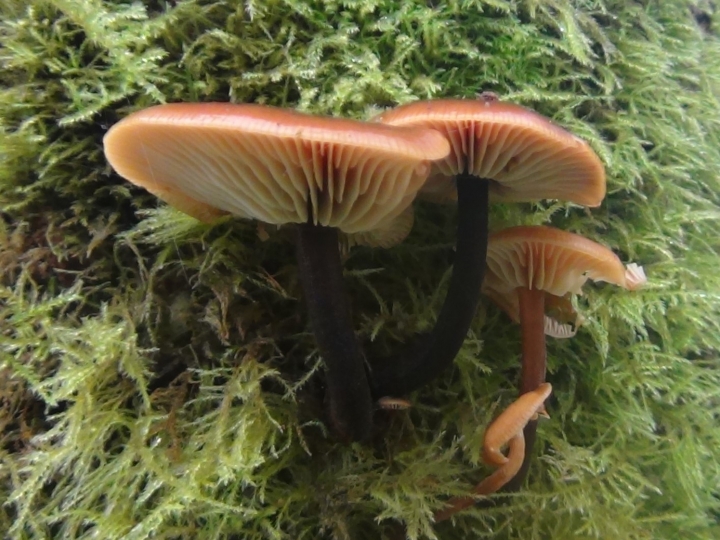















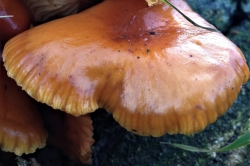
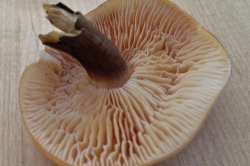
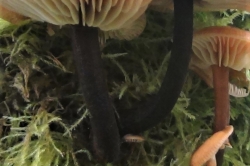
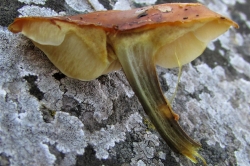
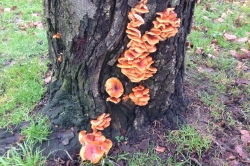
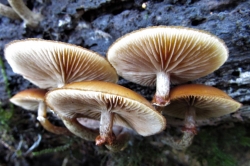
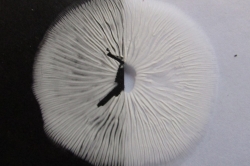






9 comments for Velvet Shank
I have found what looks just like a group of Velvet Shank mushrooms growing from a dead tree stump. They have orange, slimy caps, slightly sticky/tacky to touch, light cream gills and stems that become a darker brown towards the base of the stem. The largest of the mushrooms in the sample had a very dark, velvety stem. The only problem is that it’s the first week of October and I thought Velvet Shanks were very much a winter mushroom. We have had a couple of chilly nights, but would that be cold enough to trigger fruiting of the mushroom.
Mushrooms can quite often appear out of season but without seeing the mushrooms I couldn’t tell you if they were Velvet Shanks.
Hi, found the same thing. Will picture helps?
You can send photos to [email protected]. Please include clear photos of the mushroom/s in situ and of the gills, cap and stem and note any smells or colour changes after picking.
A friend hopes I have this on my very old cherry base. I think it’s honey fungus I’m afraid. What do you think? And what can I do if it is – roots spreading all over….
Send photos of the cap, gills, stem and growing in situ to [email protected] and we’ll try to identify them for you.
Is there a reason this mushroom isn’t in your Foraging Pocket Guide?
As it’s very common it should be in there shouldn’t it? The Funeral Bell and Sulpher Tuft could also make an appearance to help with the identification.
There are only so many pages a book can hold. We spent many days deciding what to put in going for the most common or tastiest mushrooms. It was quite difficult and we had to leave out many things we would have liked to have been included. On a positive note, we do include the Velvet Shank, Funeral Bell and Sulphur Tuft in our new Mushroom Foraging Guide.
I found your website 2 days ago, and found it really fascinating. Today I went for a walk with my dog in the rain and found these mushrooms. with your description and video, there is no doubt. I picked one today to see what it was. I’ll go back tomorrow and get some more to cook. thanks.